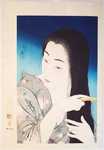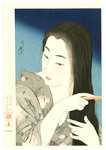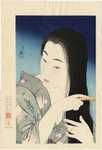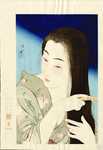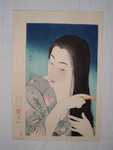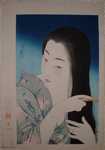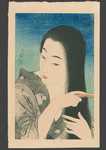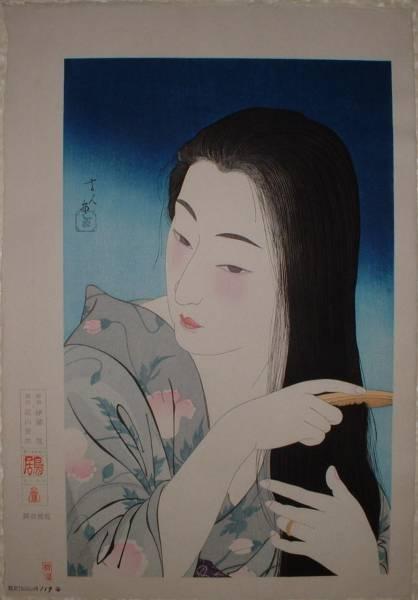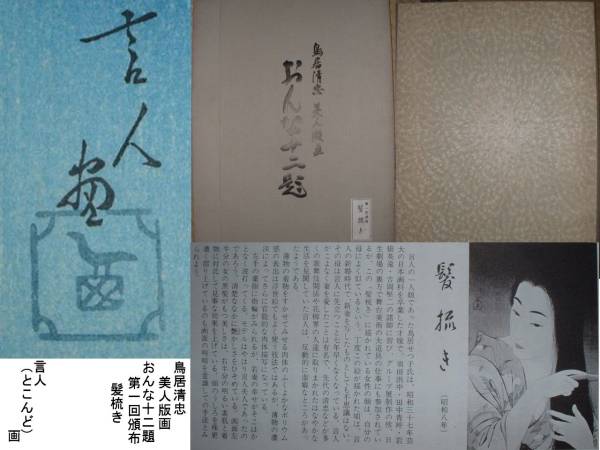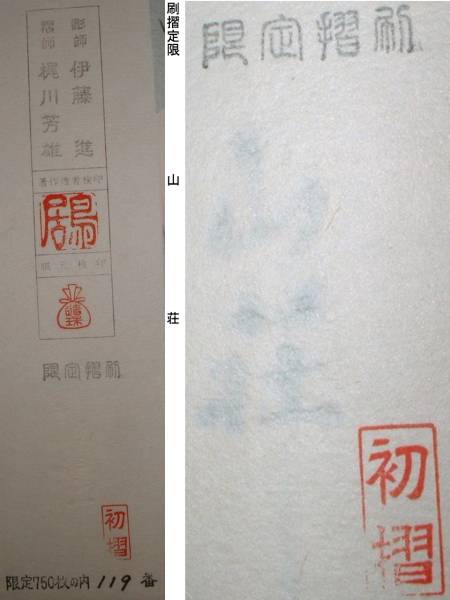| | |
| Artist: | Torii Kotondo (1900-1976) — 鳥居言人 |
| Title: | Combing the Hair (Kamisuki) — 髪梳き |
| Series: | |
| Date of first edition?: | 1932 |
| Date of this artwork?: | 1980s (may not be accurate) |
| Publisher (first edition)?: | Ikeda — 池田 |
| Publisher (this edition)?: | Ishukankokai — 遺珠刊行会 |
| Medium (first edition): | Woodblock |
| Medium (this edition): | Woodblock |
| Format (first edition): | Large Oban
|
| Format (this edition): | Oban |
| DB artwork code: | 34966 |
| Notes (first edition)?: |
Artist: TORII, Kotondo
Description: Combing her hair,
ed.100, numbered,
Scene number 7.
Dated 1932 (confirmed. Month not yet confirmed).
Limited edition of only 100 prints, after which the blocks were destroyed.
I have seen both "A Nap" and "Hair Combing" marked as scene number 7. One of them must be scene 8 in reality.
Ikeda published a total of 12 scenes.
Signed: Kotondo
Dimension: 41.0 × 25.5 cm
Re-issued in the series "Twelve Aspects of Women" circa August 23, 1988. |
|
| Notes (this edition)?: |
| The following information was taken from the original web listing of this artwork. Note that there may be some inaccuracies:
Monday, 29 September 2008
鳥居清忠 美人版画 おんな十二題 第1回頒布 「髪梳き」 限定版 版元 ㈱遺珠刊行会
当作品は鳥居派八代目 鳥居清忠 言人(ことんど)が昭和8年に制作したものを昭和51年に再刻出版されたものです。
彫師 伊藤 進
摺師 梶川 芳雄
版元 株式会社 遺珠刊行会
手漉き和紙 「山荘」の透かしあり
※用紙に福井県今立の手漉き和紙に山荘の名を漉き混んでいたアサヒビール大山崎山荘美術館の和紙を使用したのではないかと、思いますが、いかがでしょうか?
作品大きさ(図の部分) 約41.5×25.5cm
和紙大きさ 約48×33cm
タトウ紙大きさ 約54×39cm 中の台紙(ボール紙)に少々、しみあり
外包み紙(題印刷)大きさ 約55×40.5cm 薄い汚れ、少々あり
750/119番
作品はきれいです。図に関係ない、縁にうすい、うすいしみが2ヶ所ありますが、顔を近づけなければ、わからない程度です。 |
|
| Artist Bio: |
| Torii Kotondo (or Torii Kiyotada VIII) is renowned for his paintings and shin hanga prints of beautiful women. His woodblock prints, superbly carved and printed, are comparable with those of Hashiguchi Goyo and Ito Shinsui. Kotondo was born with the name Saito Akira in the Nihonbashi district of Tokyo. He was the only son among the five children of Torii Kiyotada, the seventh Torii master. The Torii school had a long tradition of painting and printmaking for the Japanese theater, extending back to the seventeenth century. Kabuki theater was still very popular in the early twentieth century and prints and painted posters were the primary means of publicity. Although Kotondo was mainly interested in studying history and archaeology, it was assumed that he would follow in his father's footsteps and join the Torii school. At age 14, Kotondo agreed to leave school and begin studies with Kobori Tomone, a yamato-e painter. Along with painting classes, Tomone taught Kotondo about the court and military practices of ancient Japan, satisfying his interest in history. A year later, he was officially adopted as the next heir of the Torii school and assumed the artist's name 'Kotondo'. While still studying with Tomone, he began designing illustrations for a theatrical magazine, Engei Gaho ('Entertainment Illustrated Magazine'), and painted kabuki posters and billboards. Torii Kotondo was the 8th Torii and the 5th Torii Kiyotada. His father was the 4th Kiyotada.
|
|



